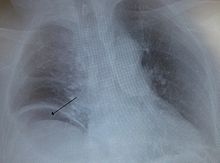
Back ثقب معدي معوي Arabic Perforació gastrointestinal Catalan Darmperforation German Perforación intestinal Spanish Perforation gastro-intestinale French התנקבות מעי HE Gasztrointesztinális perforáció Hungarian Ստամոքսաղիքային թափածակում Armenian Perforazione gastrointestinale Italian 胃腸穿孔 Japanese
| Gastrointestinal perforation | |
|---|---|
| Other names | Ruptured bowel,[1] gastrointestinal rupture |
 | |
| Free air under the right diaphragm from a perforated bowel. | |
| Specialty | Gastroenterology, emergency medicine |
| Symptoms | Abdominal pain, tenderness[2] |
| Complications | Sepsis, abscess[2] |
| Usual onset | Sudden or more gradual[2] |
| Causes | Trauma, following colonoscopy, bowel obstruction, colon cancer, diverticulitis, stomach ulcers, ischemic bowel, C. difficile infection[2] |
| Diagnostic method | CT scan, plain X-ray[2] |
| Treatment | Emergency surgery in the form of an exploratory laparotomy[2] |
| Medication | Intravenous fluids, antibiotics[2] |
Gastrointestinal perforation, also known as gastrointestinal rupture,[1] is a hole in the wall of the gastrointestinal tract. The gastrointestinal tract is composed of hollow digestive organs leading from the mouth to the anus.[3] Symptoms of gastrointestinal perforation commonly include severe abdominal pain, nausea, and vomiting.[2] Complications include a painful inflammation of the inner lining of the abdominal wall and sepsis.
Perforation may be caused by trauma, bowel obstruction, diverticulitis, stomach ulcers, cancer, or infection.[2] A CT scan is the preferred method of diagnosis; however, free air from a perforation can often be seen on plain X-ray.[2]
Perforation anywhere along the gastrointestinal tract typically requires emergency surgery in the form of an exploratory laparotomy.[2] This is usually carried out along with intravenous fluids and antibiotics.[2] Occasionally the hole can be sewn closed while other times a bowel resection is required.[2] Even with maximum treatment the risk of death can be as high as 50%.[2] A hole from a stomach ulcer occurs in about 1 per 10,000 people per year, while one from diverticulitis occurs in about 0.4 per 10,000 people per year.[1][4]
- ^ a b c Domino FJ, Baldor RA (2013). The 5-Minute Clinical Consult 2014. Lippincott Williams & Wilkins. p. 1086. ISBN 9781451188509. Archived from the original on 17 August 2016. Retrieved 4 August 2016.
- ^ a b c d e f g h i j k l m n Langell JT, Mulvihill SJ (May 2008). "Gastrointestinal perforation and the acute abdomen". The Medical Clinics of North America. 92 (3): 599–625, viii–ix. doi:10.1016/j.mcna.2007.12.004. PMID 18387378.
- ^ Langell JT, Mulvihill SJ (May 2008). "Gastrointestinal perforation and the acute abdomen". The Medical Clinics of North America. 92 (3): 599–625, viii–ix. doi:10.1016/j.mcna.2007.12.004. PMID 18387378.
- ^ Yeo CJ, McFadden DW, Pemberton JH, Peters JH, Matthews JB (2012). Shackelford's Surgery of the Alimentary Tract (7 ed.). Elsevier Health Sciences. p. 701. ISBN 978-1455738076. Archived from the original on 2016-08-17.
© MMXXIII Rich X Search. We shall prevail. All rights reserved. Rich X Search